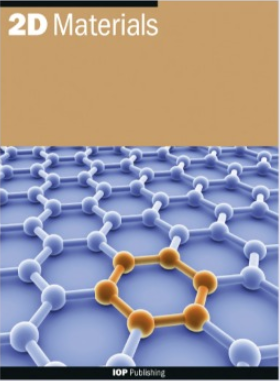是什么决定了横向异质结构中二维过渡金属二硫族化合物界面的原子结构?
IF 4.3
3区 材料科学
Q2 MATERIALS SCIENCE, MULTIDISCIPLINARY
引用次数: 0
摘要
基于具有相似原子结构但具有不同电子性质的二维(2D)材料的横向异质结构(LHs)的发展,如过渡金属二硫族化合物(TMDCs),为实现具有独特特性的光电器件开辟了新的途径。与范德华垂直异质结构相比,LHs中子系统之间的界面共价键很强,因此界面的形态(可能是相干的或包含位错的)强烈影响LH的性质。我们预测了界面的原子结构,考虑了组件的原始细胞尺寸之间的不匹配,更重要的是,使用从第一性原理计算得出的参数来预测连接材料的宽度。我们将这种方法应用于各种TMDCs,并对界面从相干型向位错型转变的时间设定了理论限制。我们通过与Au上MoS 2和ta2之间结的二维异向生长的初始阶段进行比较来验证我们的理论结果(111)。本文章由计算机程序翻译,如有差异,请以英文原文为准。
What governs the atomic structure of the interface between 2D transition metal dichalcogenides in lateral heterostructures?
Abstract The development of lateral heterostructures (LHs) based on two-dimensional (2D) materials with similar atomic structure but distinct electronic properties, such as transition metal dichalcogenides (TMDCs), opened a new route towards realisation of optoelectronic devices with unique characteristics. In contrast to van der Waals vertical heterostructures, the covalent bonding at the interface between subsystems in LHs is strong, such that the morphology of the interface, which can be coherent or contain dislocations, strongly affects the properties of the LH. We predict the atomic structure of the interface with account for the mismatch between the primitive cell sizes of the components, and more important, the widths of the joined materials using parameters derived from first-principles calculations. We apply this approach to a variety of TMDCs and set a theoretical limit on when the transition of the interface from coherent to dislocation-type should occur. We validate our theoretical results by comparison with the initial stage of two-dimensional heteropitaxial growth of junctions between MoS 2 and TaS 2 on Au(111).
求助全文
通过发布文献求助,成功后即可免费获取论文全文。
去求助
来源期刊

2D Materials
MATERIALS SCIENCE, MULTIDISCIPLINARY-
CiteScore
10.70
自引率
5.50%
发文量
138
审稿时长
1.5 months
期刊介绍:
2D Materials is a multidisciplinary, electronic-only journal devoted to publishing fundamental and applied research of the highest quality and impact covering all aspects of graphene and related two-dimensional materials.
 求助内容:
求助内容: 应助结果提醒方式:
应助结果提醒方式:


